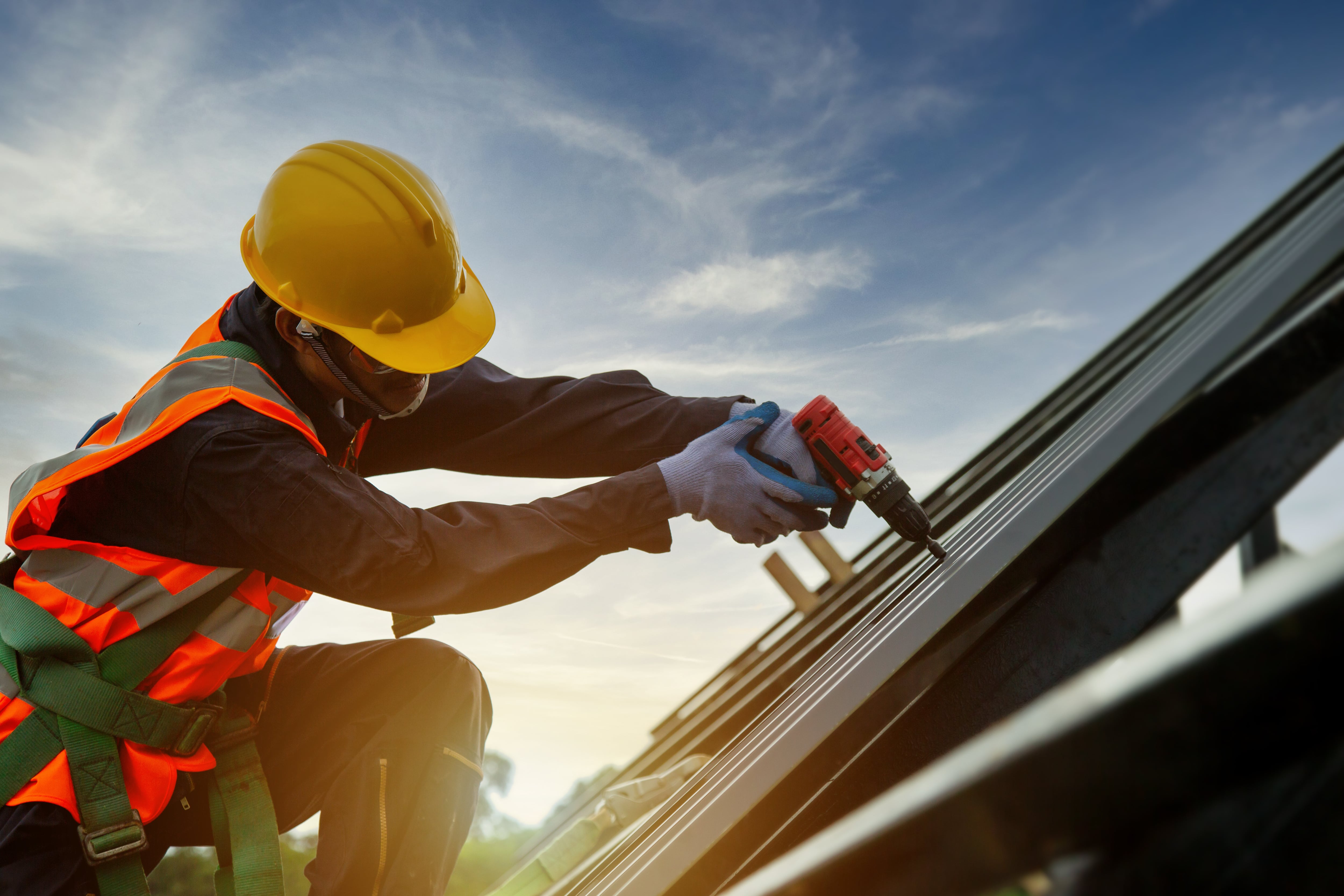Ensuring Worker Safety During Roofing Work: OSHA Standards and Best Practices

Roofing work is one of the most dangerous occupations in the United States, with a fatality rate of 59 deaths per 100,000 full-time equivalent workers in 2021 according to the U.S. Bureau of Labor Statistics.
Roofing professionals are tasked with the installation, repair, and replacement of roofs on residential and commercial buildings. Their job involves transporting and securing roofing materials, such as shingles or metal, onto roofs. To access rooftops, roofers often rely on ladders or other equipment. Falls from roofs or ladders are a leading cause of accidents in the roofing industry.
OSHA Construction Industry Standards to Protect Worker Safety at Heights
The Occupational Safety and Health Administration (OSHA) has strict regulations in place to help prevent falls from heights. These regulations include requirements for fall protection systems, ladder safety, and safety training. OSHA’s 29 CFR 1926 Subpart X is dedicated to safety protocols when using stairways and ladders during construction work. OSHA also has a dedicated construction industry standard for fall protection codified in 29 CFR 1926 Subpart M.
Click here to enroll in our OSHA Competent Person for Fall Protection Training
Listed below are some specific OSHA requirements for ladder safety.
- 29 CFR 1926.1053(b)(1) - Ladders must be used only on stable and level surfaces unless secured to prevent accidental displacement.
- 29 CFR 1926.1053(b)(5)(i) - Non-self-supporting ladders must be set at an angle so the horizontal distance between the top support and the foot of the ladder is approximately one-quarter the working length of the ladder (a 1:4 ratio).
- 29 CFR 1926.1053(b)(13) - Workers must not use the top or the top step of a stepladder as a step; doing so could lead to serious injury.
Worker Safety When Working on Roofs
OSHA requires that all workers on roofs 6 feet or more above a lower level be protected from falls by a fall protection system. There are three types of fall protection systems that are allowed under OSHA regulations:
1. Guardrail Systems
Guardrail systems consist of a top rail, midrail, and toeboard. The top rail must be at least 42 inches high; the midrail must be at least 21 inches high, and the toe board must be at least 4 inches high.
2. Safety Net Systems
Safety net systems consist of a net that is suspended below the roof edge. The net must be at least 6 feet deep and must be able to catch a worker who falls from the roof.
3. Personal Fall Arrest Systems
Personal fall arrest systems consist of a harness, lanyard, and anchorage point. The harness must be worn by the worker, the lanyard must be attached to the harness, and the anchorage point must be secure.
Ladder Safety
OSHA also has specific requirements for ladder safety on roofs. These requirements include:
- Ladders must be fully extended and secured at the top and bottom.
- Ladders must be placed on a stable and level surface that is free of debris.
- Ladders must be at least 3 feet away from the edge of the roof.
- Ladders must be secured to prevent accidental displacement.
- Ladders must not be used on slippery surfaces unless secured or provided with slip-resistant feet.
- Ladders must be extended at least 3 feet above the upper support level if employees are to leave or mount the ladder at that level.
- Ladders must be loaded no more than their maximum intended load.
- Ladders must be inspected before each use for any defects.
- Workers must use both hands when climbing and descending ladders.
- Workers must be trained in the safe use of ladders.
Additionally, when using ladders, workers should also:
- Always face the ladder when climbing or descending;
- Keep their body inside the side rails;
- Use a three-point contact (two hands and a foot, or two feet and a hand) when climbing or descending the ladder;
- Never overload a ladder;
- Never use a ladder that is damaged or defective; and
- Be aware of your surroundings and avoid working near overhead hazards.
Additional Safety Considerations
Below are some additional safety precautions that should be taken when working on a roof.
- Always wear a hard hat, safety glasses, and steel-toed boots.
- Be aware of your surroundings and watch out for hazards such as loose shingles, nails, and electrical wires.
- Never work alone on a roof.
- If you are feeling tired or dizzy, do not work on the roof.
OSHA General Industry Standard for Use of Ladders
OSHA also has a general industry standard dedicated to Ladders codified in 29 CFR 1910.23 – Ladders. This standard is applicable to all employers who must ensure that all ladders utilized comply with this regulation. The only exceptions are when ladders are used during emergencies such as fires or tactical operations and training for such work, and if the ladder is an integral part of a machine or equipment.
This general industry standard about ladders also explains the importance of ladder safety when working on roofs. The focus is on fixed ladders for roof access and compliance with design requirements and the need for such fixed ladders to be equipped with appropriate fall protection systems such as guardrails, safety nets, and/or personal fall protection systems, such as personal fall arrest, travel restraint, or positioning systems.
OSHA defines a Fixed ladder as a ladder with rails or individual rungs that is permanently attached to a structure, building, or equipment. Fixed ladders include individual-rung ladders, but not ship stairs, step bolts, or manhole steps.
Working on Roofs During Hot Weather
As we find ourselves in the midst of summer, it's essential to recognize the potential dangers of working on roofs during hot weather. High temperatures can increase the risk of heat exhaustion or heat stroke. To ensure worker safety while working on a roof in hot weather, follow these best practices.
- Start early and finish early. The hottest part of the day is usually between 10 am and 2 pm. If possible, try to schedule roofing work for before or after these hours.
- Wear light-colored clothing. Dark clothing absorbs heat, so it's important to wear light-colored clothing that will help you stay cool.
- Apply sunscreen. Sunscreen is essential for protecting your skin from the sun's harmful rays. Be sure to reapply sunscreen every two hours, or more often if you're sweating a lot.
- Drink plenty of fluids. It's important to stay hydrated, especially when working in hot weather. Drink plenty of water or sports drinks throughout the day.
- Take breaks. Don't try to work through the heat. Take frequent breaks in the shade to cool down and rehydrate.
- Be aware of the signs of heat exhaustion or heat stroke. If you experience any of the symptoms (headache, dizziness, nausea, vomiting, confusion, fatigue, muscle cramps, rapid breathing, hot, dry skin, and fainting) stop working and seek medical attention immediately. Read our article on Protecting Workers from Heat Stress to better understand the dangers of heat exhaustion.
OSHA Training Requirements
Remember that OSHA required all workers exposed to fall hazards to be trained on the proper use of fall protection systems and ladder safety. This training must be conducted by a qualified person and must be documented.
OSHA defined a Qualified Person as one who, by possession of a recognized degree, certificate, or professional standing, or who by extensive knowledge, training, and experience, has successfully demonstrated his/her ability to solve or resolve problems relating to the subject matter, the work, or the project.
By following OSHA's standards for roofing work safety and working at heights, employers can reduce fall, slip, and trip accidents at the workplace leading to increased worker safety and higher levels of compliance with regulatory standards for worker safety and health.
Ensure worker safety by enrolling them in a Fall Protection Training course developed in line with OSHA standards.

 EN |
EN |  ES
ES






























































































































